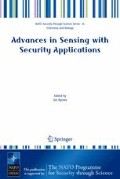Abstract
In order to realise scalability of chemical sensors in extensively deployed wireless sensor networks, considerable materials challenges must be overcome. Conventional devices are currently far too expensive and unreliable for massive long-term field deployment. Cost can be driven down by imaginative approaches to transduction and instrument design. For example, we have produced a complete instrument based on LED measurement of colour changes that has sub-micromolar detection limits for a number of heavy metals for around $1.2 In its current form, the device also has a short distance wireless communications functionality and very low power consumption. However, chemical sensors capable of long-term reliability will require imaginative solutions to the key issue – how can the sensing films/membranes in chemical sensors maintain predictable characteristics in long term deployment?
Access this chapter
Tax calculation will be finalised at checkout
Purchases are for personal use only
Preview
Unable to display preview. Download preview PDF.
References
Michio Kaku Visions — How Science will Revolutionise the 21st Century, Anchor Books, New York, 1997, p. 31.
D Diamond and K Nolan Anal. Chem., 73 (2001) 22A–29A.
A Ceresa, E Bakker, B Hattendorf, D Gunther and E Pretsch Anal. Chem., 73 (2001) 343–351.
D Diamond Anal. Chem., 76 (2004) 278A–286A.
Ron Ambrosio Internet-Scale Data Acquisition and Control Systems — Programming Paradigm Challenges, Paper presented at the conference, Creating An Expanded DER Industry, November 28–30, 2001, Loews L’Enfant Plaza Hotel, Washington, DC.
Alan Mainwaring, Joseph Polastre, Robert Szewczyk, David Culler and John Anderson, Wireless Sensor Networks for Habitat Monitoring, in Proceedings of the first ACM international workshop on Wireless sensor networks and applications, Atlanta, Georgia, USA September 28 2002, 88–97.
See http://www.greatduckisland.net
See http://cens.ucla.edu/
’Remodeling the Wireless Landscape — Technologies of Massive Disruption,’ a paper presented by Dr. J. Schwarz da Silva, Head Communications and Network Technologies, European Commission (DG-INFSO), at Wireless World Research Forum Meeting, New York, 27–28 October, 2003, see www.wireless-world research.org for more details.
An up to date list of applications can be found at www.bluetooth.com.
See www.zigbee.org.
‘Motorola goes with ZigBee Protocol for Wireless Networking,’ press release, Motorola Inc., September 23rd 2003, Phoenix, Arizona.
See http://www.xbow.com/Products/Wireless_Sensor_Networks.htm
Latest TinyOS source code is available free at http://sourceforge.net/projects/tinyos/.
Statement from Dan Rosen, formed head of Microsoft Advanced R&D, quoted by Alex Lightman in a presentation at the Wireless World Research Forum Meeting, New York, 27–28 October, 2003, see www.wireless-world-research.org for more details.
www.eecs.berkeley.edu/ pister/SmartDust/in2010
Michaela Bowden and Dermot Diamond, Sensors and Actuators B 90 (2003) 170–174.
A Daridon, M Sequiera, G. Pennarun-Thomas, J Lichtenberg, E Verpoorte, D Diamond and NF de Rooij, Sensors and Actuators B, 76/1–3, (2001) 235–243.
Margaret Sequeira, Michaela Bowden, Edel Minogue and Dermot Diamond, Talanta, 56, Issue 2, (2002) 355–363.
Margaret Sequeira, Antoine Daridon, Jan Lichtenberg, Sabeth Verpoorte, N F de Rooij and Dermot Diamond, Trends Anal. Chem., 21 (2002), 816–827.
Organic and Biomimetic Designs for Microfluidic Systems, Jaisree Moorthy, David Beebe; Anal. Chem.; 2003; 75(13); 292A–301A.
Allen Northrup, CEO of Microfluidic Systems Inc., Pleasanton, California, personal communication.
Biological Warfare Detection, David R. Walt and David R. Franz, Anal. Chem., 2000; 72(23); pp. 738 A–746 A.
Mary T. McBride, Don Masquelier, Benjamin J. Hindson, Anthony J. Makarewicz, Steve Brown, Keith Burris, Thomas Metz, Richard G. Langlois, KarWing Tsang, Ruth Bryan, Doug A. Anderson, Kodumudi S. Venkateswaran, Fred P. Milanovich, and Bill W. Colston, Jr., Anal. Chem., 75 (2003) 5293–5299.
See ‘The Times’ (London), March 28th 2004, ’Mobile to Serve as Dirty Bomb Detectors’.
Sarah Brady, Dermot Diamond, King-Tong Lau, Sensors and Actuators A: Physical, Volume 119, Issue 2, 13 April 2005, Pages 398–404
Lucy E Dunne, Sarah Brady, Barry Smyth, Dermot Diamond, J. Neuroengineering Rehabil. 2005 Mar 1;2(1):4.
See http://www.intel.com/research/prohealth/.
S Nittel, A Stefanidis, I Cruz, M Egenhofer, D Goldin, A Howard, A Labrinidis, S Madden, A Voisard and M Worboys, Report from the First Workshop on Geo-Sensor Networks, 33 (1) (2004) 141–144.
Author information
Authors and Affiliations
Editor information
Editors and Affiliations
Rights and permissions
Copyright information
© 2006 Springer
About this paper
Cite this paper
Diamond, D. (2006). INTERNET-SCALE CHEMICAL SENSING: IS IT MORE THAN A VISION?. In: Byrnes, J., Ostheimer, G. (eds) Advances in Sensing with Security Applications. NATO Security Through Science Series, vol 2. Springer, Dordrecht. https://doi.org/10.1007/1-4020-4295-7_06
Download citation
DOI: https://doi.org/10.1007/1-4020-4295-7_06
Publisher Name: Springer, Dordrecht
Print ISBN: 978-1-4020-4284-3
Online ISBN: 978-1-4020-4295-9
eBook Packages: Biomedical and Life SciencesBiomedical and Life Sciences (R0)

